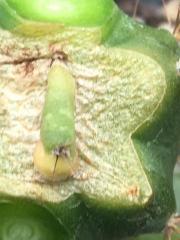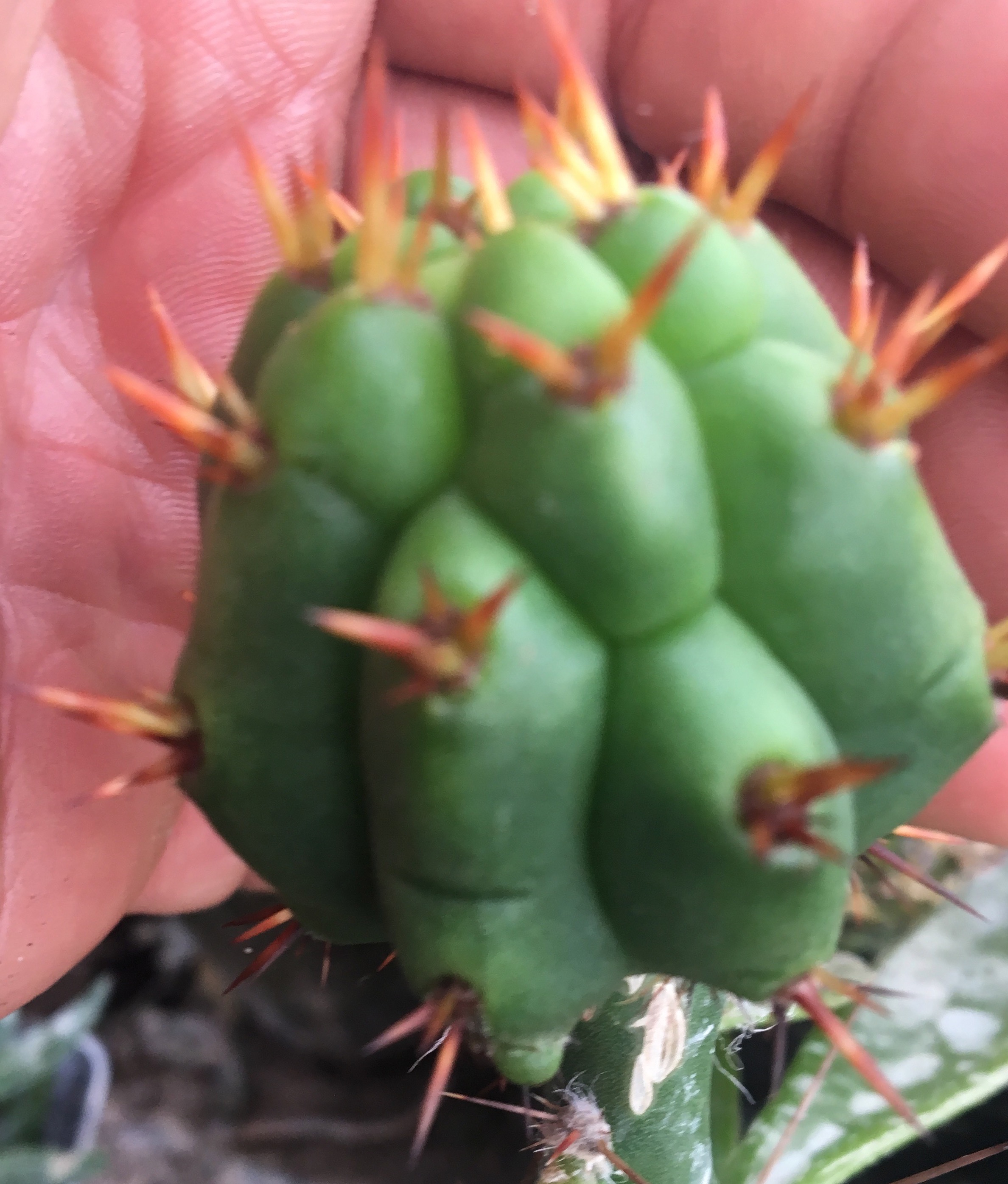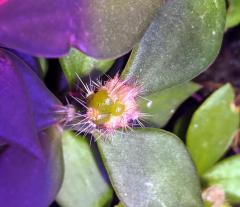-
Content count
1,233 -
Joined
-
Last visited
-
Days Won
44
Content Type
Profiles
Forums
Calendar
Blogs
Gallery
Store
Everything posted by Inyan
-
Halloween grafting... Halloween grafting.m4v no glasses and just slits to see through.
-
I won't bore you with a long list. Instead, one very high quality cross that I am extremely excited about.... In the cup of water as we speak.
-
https://www.youtube.com/watch?v=uT3SBzmDxGk
-
Round two....
-
Lophophora williamsii x Lophophora fricii 21 OCT18 26 days
-

Grafting Lophophora jourdaniana var. mammilaris 18 OCT 18
Inyan posted a topic in Cacti & Succulents
Grafting Lophophora jourdaniana var. mammillaris on 18 OCT 18 at 1700. I'm a bit more hopeful with this graft made today and if everything proceeds as planned I will be showing pictures as this one progresses. Note, it is cold out as winter is approaching so we shall see how this graft does given the cold temperatures. Parafilm wrapped around stock. Seedling selected Seedling cut horizontally as was stock. Seedling placed on vascular bundle Parafilm placed over top of seedling to hold it in down so as to keep it from floating away or blowing off etc. Graft left outdoors as I don't have time to bring her in for special treatment. -

Grafting Lophophora jourdaniana var. mammilaris 18 OCT 18
Inyan replied to Inyan's topic in Cacti & Succulents
For me at least, I think it would help to identify L. jourdaniana var. mammilaria when compared to Lophophora jourdaniana. I mean, I get the difference in the name, but for me... it helps to see a lot of pictures showing the differences as sometimes they are subtle to me. Could be I just need more exposure though. -

Grafting Lophophora jourdaniana var. mammilaris 18 OCT 18
Inyan replied to Inyan's topic in Cacti & Succulents
Quick questions for you @MountainGoat 1. Did you graft yours? 2. Were yours sourced from Koehres? 3. Why not post here now? I love to see seedlings as they progress through their stages. Or am I just a little nutty that way? At any rate, I'd love to see a bunch of different Lophophora jourdaniana var. mammilaris on a single thread. Especially so if there is any variation from seedling to seedling or if sourced from a place other than Koehres. -
I have literally grow many of my Trichocereus in a bog without ever trimming their roots. In fact, growing in a bog like that tends to stunt their roots. If your roots are root bound, it is common practice to cut through them or untangle them so as to free them up, but I can't see doing anything more than that. Light pinch off the bottom of the roots or and run your fingers through the sides of the roots. If the roots are too small to do that you can use another tool like a chopstick, etc. This applies to other plants besides just cacti as well. If you want to prune your Astrophytum tap roots on the other hand go right ahead as I have seen Astrophytum grown hydroponically that way as it is the finer roots that you need in home cultivation.
- 1 reply
-
- 1
-

-

Grafting Lophophora jourdaniana var. mammilaris 18 OCT 18
Inyan replied to Inyan's topic in Cacti & Succulents
The simple answer is because that is how it was labeled when I purchased it. LOPHOPHORA jourdaniana 10K - v mammilaris 10K (3185) https://www.koehres-kaktus.de/shop/Cactus-seeds/Lophophora---1_364-2.html or LOPHOPHORA jourdaniana 10K (4930) https://www.koehres-kaktus.de/shop/Cactus-seeds/Lophophora---1_364.html Mammilaris though... refers to nipples so you know I had to have it. -

Grafting Lophophora jourdaniana var. mammilaris 18 OCT 18
Inyan replied to Inyan's topic in Cacti & Succulents
Lophophora jourdaniana var. mammillaris on 20 OCT 18 day 2 Note, rained today and as I keep my grafts outdoors this time of year graft was fully drenched. -
Just to consolidate... Koehres pollinations Lophophora williamsii Huizachex Lophophora koehresii Lophophora williamsii x Lophophora fricii Lophophora williamsii x Lophophora fricii f2 Lophophora koehresii x Lophophora fricii Lophophora koehresii x Lophophora diffusa Lophophora fricii El Amparox Lophophora koehresii Lophophora fricii x Lophophora diffusa Lophophora diffusa x Lophophora koehresii Kada Lophophora diffusa x Obregonia denegrii Other hybrids as per http://www.magicactus.com/lw_jourdaniana.html and other sources Lophophora williamsii x Mammilaria bocasana Lophophora williamsii x Mammilaria zeilmanniana Lophophora williamsii x Mammilaria Strombocactus disciformis Lophophora williamsii x Turbinicarpus pseudomacrochele Lophophora williamsii x Ariocarpus fissuratus Lophophora williamsii x Astrophytum asterias Lophophora williamsii x Epithelantha micromeris Lophophora jourdaniana Lophophora jourdaniana var. mammilaris Now, much of what I have found did not include locality information for specimens used in these crosses nor did they always include whether the specimen chosen was a self-fertile or not. Also note, there is not much information to be found on how these pollinations occurred. Was the flower emasculated first? Was a donor pollen or mentor pollen utilized? Was a cut style approach used? Given that often it is possible for a particular phenotype to be dominant over another was the cross carried out further to the f2 or even backcrossed to help bring out the recessive traits or was it just assumed the cross was successful without further breeding of the progeny? Were the progeny sterile thus making an f2 impossible to make?
-
Lophophora williamsii x Lophophora fricii day 24
-

Grafting Lophophora jourdaniana var. mammilaris 18 OCT 18
Inyan replied to Inyan's topic in Cacti & Succulents
Lophophora jourdaniana var. mammillaris on 19 OCT 18 day 1 -
Here you go, these are the only photos I can find unfortunately of this crested specimen I grafted at a much smaller size than is shown in these photos. If memory serves me, it did not lose its crested form initially when grafted the first time. However, I have cut on this one a few times since this photo was taken and some pieces did indeed revert for a time. I will take more photos when I get home to see what is going on with this one now. Bottom line, small crested pups grafted can indeed revert and then go back to crested, but need not ever revert. In the mean time...
-
Trying not to edit my posts too much, so I'll just add this below. Have you also heard the rumor that a crested cutting that is too small also will revert and lose its ability to crest? Perhaps that is indeed true with a particular crest. However, my own experience proves otherwise. My suggestion, test something that seems a little off before you discount it, but realize that results may vary simply due to the specimen used. The same thing happens in hybridization. Someone assumes a cross can't happen with a particular species because they have attempted the cross a few dozen times with the same exact specimens. Pollen can be quite variable from one locality to the next with some species. Sometimes experiments have to be repeated many more times than we would like before positive results are found and yes, sometimes one may find that those positive results are not what you were actually looking for. False positives and the like abound. The right method may simply not have been found yet or if the right method is known the method may be beyond the expertise of the one trying. There are often many different variables to look at. Back to your crested specimen, I will look through my pictures to see if I can find a very tiny less than pea sized graft I did of a crested form that reverted for very little bit. I then cut that specimen back again and prompted it to go revert again. Round and round we go, but the story is the same. Crested forms when cut very tiny will often revert to normal, but then often go right back to crested. It all depends on the genetics of the particular crest one is talking about. I have another crest I cut back on where several pieces reverted for several inches. One piece is just now starting to crest, but it is still only a few inches tall. Do your own experiments and find your own answers. That is the best advice I can give. When your ready to give up and are satisfied with your answer realize there may yet still be more to the story.
-
This would be great if someone discovered a way to take the cresting genetics out of a specimen. The ability to selectively force a cacti to remain stable forever could come in handy. What I am wondering though is that since the cresting phenomenon can often be passed down to a crested's progeny, will cacti thus treated also no longer have crested offspring? Or more interestingly, will crested cacti thus treated also have their offspring revert permanently as well? Perhaps what is needed is a day by day or week by week type progression thread of bap on a few different crests to prove this out? What may be true with one specimen may not be true with another. The difficulty one might find though is that some crests take weeks to crest from seed and some take years. I'd suggest you experiment with a crest form that only took weeks to form a crest from seed rather than one that took years to form as your experiment might take an excessively long time to confirm if you chose a specimen that only crested later in life. I am sure there is no shortage of crested forms that have crested within a few weeks time here on these very forums.
-
"Crossing experiments within the genus Lophophora Gerhard Koehres has reported successfully making the following crosses within the Lophophoras (success being judged by the production of seeds that have then been grown into actual seedlings) Koehres noted these to be self-sterile: L. alberto-vojtechii L. diffusa L. fricii L. koehresii L. williamsii El Huizache SLP L. williamsii Norias del Conde SLP Koehres listed 25 additional L. williamsii populations that he had determined were self- fertile. L. williamsii Parras, Coahuila is said to be self fertile despite most people now placing this with L. fricii. Koehres did not get pollination for L. koehresii using pollen from L. williamsii Huizache but found L. williamsii Huizache could be successfully pollinated using pollen from L. koehresii. Koehres also successfully pollinated L. koehresii with pollen from L. fricii and L. diffusa. (Kada used a self-fertile L. williamsii and could get no pollination using pollen from L. diffusa, L. fricii and L. koehresii.) L. fricii was reported by Koehres to be successfully pollinated using pollen from L. koehresii and L. diffusa. (Kada reported failures after 7 attempts involving L. diffusa pollen, 13 with L. williamsii and 18 L. koehresii pollen but reported success for 1 attempt involving a L. williamsii.) L. diffusa was successfully pollinated by Koehres using pollen from L. koehresii. (Kada has recorded a consistent failure after 11 attempts with pollen from L. fricii, 4 with L. koehresii pollen and 3 using L. williamsii pollen.) L. koehresii was successfully pollinated by Koehres using pollen from L. diffusa and L. fricii but not with pollen from L. williamsii Huizache (Kada reported successful pollination for 19 attempts using L. fricii pollen but none in 4 tries with L. diffusa pollen and 29 with L. williamsii pollen) Koehres found that fruit can form from the early flowers within around 8 weeks but for the later blossoms the fruit often do not emerge until the following year. Koehres also commented that the self fertile populations are very uniform in comparison to the self sterile populations which are more highly variable in the shape of the body and the flower. Lophophoras suspected of being hybrids There are a number of Lophophoras in horticulture that are known to be or suspected to be hybrids. Most intriguing to me are Kada’s Lophophora diffusa X Obregonia denegrii. I look forward to hearing how those seedlings grow up. At some point an entry on this subject will be added here but the work is still ongoing so only this note is presently being included." https://sacredcacti.com/blog/lophophoras/'' And for those interested in f2 Lophophora hybrid seed.... https://www.koehres-kaktus.de/shop/Cactus-seeds/Lophophora---1_364-10.html The above is Lophophora williamsii x Lophophora fricii f2. One more hybrid f2 of course... https://www.koehres-kaktus.de/shop/Cactus-seeds/Lophophora---1_364.html Not sure if anyone else is growing these, but for those interested in hybrids they are worth a shot. Lophophora from one locality to the next has such variability in pollen it makes sense that some crosses might not be possible with one locality, but possible with another. Whatever the case may be, you have to salute those hybridizers that have been successful in these endeavors as well as those that were bold enough to try and fail.
-
-
You obviously have mad skills when it comes to picture taking as well as taste in cacti judging by your photo's. With that being said, this is the best I could come up with today and it took 32 pictures for me to get the one I am okay with. Lophophora williamsii x Lophophora fricii day 23 Awesome work by the way! @irabionist. I would love to have some of the genetics you have to say the least as well.
-
Lophophora williamsii x Lophophora fricii day 22
-
Lophophora williamsii x Lophophora fricii day 21
-
Lophophora williamsii x Lophophora fricii day 20
-
Lophophora williamsii x Lophophora fricii day 19

